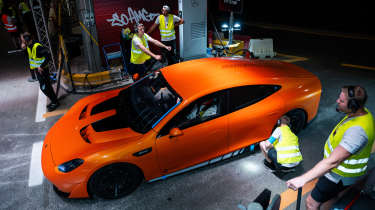The Mercedes-AMG GT XX concept is a 220mph saloon with electrified paint
Affalterbach’s GT XX might be a concept, but it’s already broken multiple records to prove the platform that powers it. We’ve been onboard to find out how
Despite ever changing market demand and regulatory chaos, Mercedes-AMG is one of just a few manufacturers that has yet to scale back its electrification plans. A new V8 is on its way, but the development of the all-new, next-generation AMG.EA platform is still well and truly underway. Our first look at AMG’s future comes in the form of this: the Concept AMG GT XX.
Before purists turn away, some consolation is that the man behind the AMG.EA platform beneath this car and upcoming production model, Oliver Wiech, is a petrol head at heart. Having previously worked as engine designer for the M113 V8 before going onto lead development for AMG during the era of the iconic naturally aspirated 6.2-litre M156/159, he’s no stranger to what makes an AMG so desirable – his favourite driver’s car from the range is the SLS.
> Mercedes Concept AMG GT Track Sport – is an AMG 911 GT3 RS rival inbound?
That cringeworthy ‘SO AMG’ branding and distinct lack of a V8 make it a difficult car to get behind at a glance, but look past this and towards the engineering at play and it becomes clear why AMG is so proud of this project. Unlike the vast majority of concepts, this is a fully functional (and surprisingly well finished, more on that later) vehicle capable of achievements usually confined to the press releases of vapourware hypercars. There’s good reason for its impressive capabilities too, as its underpinnings are already being prepared for series production.
Powertrain, 0-62mph and top speed
Just about everything beneath the GT XX’s bodywork is cutting edge, from its motors to its battery and the aerodynamics that help makes the most of that package. For power, AMG has employed British firm Yasa (owned by Mercedes) to supply bespoke axial-flux motors, two at the rear and one at the front. These motors are something we’ve already seen in the likes of the Ferrari SF90 and Lamborghini Revuelto, but AMG is the first to adopt them in a full EV. Three times more power dense than the typical radial flux motor, the integration of this technology allows for more packaging flexibility, lower weight figures and greater efficiency overall.
As if they didn’t provide enough of a performance benefit alone, Mercedes-AMG has gone a step further with the use of planetary gear sets on each motor (like the electric G-class), a differential on the front motor for torque vectoring and an actuator to mechanically disengage the front motor when it’s not needed, eliminating losses in the motor entirely.
The result of this is a healthy peak output of 1341bhp, enough for a 2.5sec 0-62mph time and a top speed of over 223mph. Based on our brief passenger ride at the Nardò test facility following its record run, we believe it.
Battery and charging
Those trick motors aren’t much use without a battery to power them, and thankfully GT XX utilises a special one. Chock full of 3000 cylindrical Nickel Cobalt Manganese Aluminum (NCMA) cells, the pack is both considerably easier to keep cool and has a much better power density than the alternatives. Mercedes-AMG quotes energy density of 300Wh/kg, almost twice that of even something like the Rimac Nevera with its c170Kw/kg rating.
An exact kWh capacity is yet to be disclosed, but combine that power density number with the typical 500kg weight of EV battery packs and you get a 150kWh figure. Of course, this isn’t final, but it’s safe to assume capacity will be much improved over the current alternative.
Not only is the pack optimised through the use of new battery chemistry, its cylindrical cells are also much easier to cool. The entire pack is liquid cooled, with fluid running between, above and beneath each of the cells in efforts to keep every one at the exact same temperature – any hot spots can reflect in the performance of the entire pack, reducing output overall.
Combined with independent cooling systems for each of the two motor packs, this is all hooked up to a huge front-mounted radiator behind its grille. That radiator is fed fresh, cool air to varying degrees depending on the state of active ‘shutters’, resulting in cooling performance up to five times more efficient than anything else on the market, largely thanks to the use of a huge fan. Typically the highest demand for cooling is while under way, but here, it’s while charging – the system performs so well that they’re yet to see any performance degradation due to excess heat while on the move.
The requirement for such extreme cooling during charging is that the GT XX can accept power at beyond 850kw, over double the speed of any car currently on sale in the UK. AMG has worked with Alpitronic to its own CCS 2 charger based on an existing 1000kw-capable truck charging system, which is set to roll out across Europe (UK included) over the coming years. For reference, this adds 253 miles of range in just 5 minutes.
Setting a world record (and breaking many more)
Not only does Mercedes-AMG still hold the record for fastest production car around the Nürburgring with the AMG One hypercar, it’s achieved another with the GT XX. Having covered 3404 miles in just 24 hours at the Nardò test facility in Italy, beating the previous EV record by 932 miles, the team decided to keep going to see just how far they could take it. The outcome was a non-stop eight-day drive at an average of 186mph, covering over 25,000 miles (and breaking 25 performance records) in the process.
As you might imagine, this was no easy feat. A total of 17 drivers including George Russell and names from its various racing programmes took part in the record attempt, each driving for between 1 and 1.5 hours through day and night. A total of 135 experts were part of the attempt too, working in three shifts in order to ensure performance for not only the car, but the people behind it.
Mercedes-AMG wouldn’t disclose just how long each car lasted between charges, but it’s fair to assume there were a fair few stops required for the attempt. To supply such huge quantities of power, they even had to build their own temporary electrical infrastructure, laying 1.5 miles of 20,000V cable to bring 2.5MW of power to a set of three 1000kw chargers. The system worked flawlessly during the attempt, with only a local power outage briefly stopping play – thankfully the governing body behind the record didn’t ask them to start again…
Given the huge mileage and forces at play, each car required 23 wheel changes during the attempt (though some tyres were later reused following a cooldown period). Developed specifically for this car, the Michelin Pilot Sport 5 'energy' tyre features a combination of an 'adaptive' compound in the centre of the tread for optimum performance (in both the wet and dry), flanked by an 'Energy Passive Compound' either side designed to reduce energy consumption.
It wasn't just the tyres that took a beating, as the batteries also saw their fair share of degradation over the run thanks to the constant load and fast charging, experiencing the equivalent of 100,000 miles of normal road use. Despite this, AMG saw little to no degradation in actual output, with the first and last 24 hours almost identical in time – engineers estimate battery health to be over 90%.
What we know about the production car
As far fetched as this all seems, there is real production relevance. The GT XX’s motor setup and battery are both destined for the road car, but we’ll have to wait and see where final output and performance numbers lie. The overall design, glasshouse and interior will all see a complete overhaul in production spec to bring it in-line with road homologation, but visual cues will undoubtedly return.
What the production car will get that the concept doesn’t is a synthesised V8 ‘engine’ sound, combined with augmented gear shifts in a similar fashion to the Hyundai Ioniq 5 N – the headlights are even designed to carry this engine sound to the exterior, using the cavities to boost volume. It’s this system that helps make the Hyundai one of the best driver’s EVs on sale, so we’re fascinated to see how it’ll play out in a more premium package.
Aerodynamics, design and plasma
The GT XX is effectively a modern, four-door interpretation of the radical C111 of the 1970s, with the same aero-led silhouette, wide-set headlights and low, full-width grille. It even shares its metallic orange paint.
Like the highly efficient but not-so performance-oriented EQ XX that came before it, there’s a strong focus on aerodynamic efficiency here. A drag coefficient of just 0.198 Cd makes it super efficient, but the tricky part has been to achieve this while retaining stability at its high top speed. The overall shape was designed with this in mind, but active aero elements such as flaps on the wheels (powered via an in-wheel battery that charges using rotation forces alone), a rear wing, louvres within the wheel arches and those shutters on the front grille all contribute. During the high speed record the car didn’t require its rear wing at all for stability, proving just how inherently stable the platform is.
While deactivated during the record run, Mercedes-AMG has also become the first manufacturer to incorporate a plasma actuator on a full-scale car with the GT XX. As science fiction as this sounds, the results are very real, with a current induced across two electrodes beneath the surface of the paint to generate a small amount of airflow, in-turn assisting in the detachment (or attachment) of airflow where it otherwise might struggle to do so. The benefits are potentially huge, allowing for greater design flexibility without an impact on aerodynamic efficiency – Mercedes even says it’s effective at up to 124mph, uses less than 50w while active and has zero moving parts.
Our experience onboard the record-setting AMG GT XX
A relatively modest 155mph is the peak speed we reached during our run onboard the GT XX Concept, but without a speedometer, I could have been convinced we were travelling at no more than the national speed limit. Admittedly, the surface of Nardò test circuit is considerably better than the typical British road, but the lack of buffeting and required steering inputs was impressive nonetheless. It really does feel like a car more than capable of 220mph+ beyond just its powertrain.
Power on acceleration is just as strong as you’d expect, but our run was primarily for high speed stability, with a brief moment to experience full regenerative braking on pit entry. This is another area the GT XX pulls ahead of alternatives, as it’s capable of pushing up to 550kw of charge back into the battery from regeneration alone – despite the 25,000 miles covered, both record cars didn’t require new pads or discs as a result (although they are carbon ceramic anyway for when they’re needed most).
Perhaps just as impressive as the stability is the leisurely power draw at such high speeds. On our run the GT XX was displaying between 10-15% power usage at 155mph…
The cabin is just as wild as a concept should be, featuring a retro, cyberpunk-esque theme with its centre piece a nod to electrical circuitry. There’s plenty of ambient lighting through, as in Mercedes products we see today, with this linked to the status of the car to provide the driver with information in their periphery. Sadly though, there are virtually zero physical buttons, making a heavily touch-sensitive interface in the production article likely.
The cabin also features unique materials that will eventually make their way into production cars, with Labfiber Biotech leather created primarily with tyres from AMG’s GT3 cars, tanned in the same way leather is for a similar finish (and smell). Mercedes has also worked to develop a biodegradable material created by feeding bacteria with sugar (yes, really) to create a protein with the same data as silk.
The GT XX is not a car that’ll make it to the road, but the fascinating technology behind it will. Even beyond the flagship AMG.EA-based saloon (and SUV) to launch in the coming years, this technology will undoubtedly trickle its way down the product line to benefit much more accessible models. Now we just need to drive the production car…
Mercedes-AMG GT XX concept specs
| Powertrain | Triple axial-flux motors, all-wheel drive |
| Power | 1341bhp |
| Torque | TBC |
| 0-62mph | <2.5sec |
| Top speed | >224mph |
| Charging speed | >850kw |
| Aerodynamic efficiency | 0.198 Cd |
| Battery | kWh tbc, Nickel Cobalt Manganese Aluminum |















